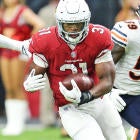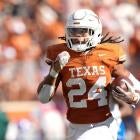Every NFL season is a small sample, and every offseason features significant turnover. While we often discuss how coaching and personnel changes might impact future results, it can be difficult to appropriately weight how past outcomes were impacted by variance.
Ex Post Outcome is a series dedicated to analyzing 2018 results through this lens to provide actionable intel for how to exploit recency bias in 2019 drafts.
Though David Johnson finished ninth among running backs in PPR Fantasy points last season, managers who took him as high as first overall are quick to explain that didn't make his season a success.
They're right, of course. His end-of-season rank was mostly the result of staying healthy enough to play 16 games as well as a large gap between the elite backs and the second tier. Johnson finished more than 80 points behind the overall top five, and his 15.5 points per game significantly trailed the eight backs who posted more than 20 while playing at least 10 games.
Of course, last we saw him before 2018 -- save for a partial game in Week 1 of 2017 -- he averaged more than 25 points per game on his way to the only 400-point running back season since 2006.
So what happened last year? And what is a reasonable expectation for 2019?
Reviewing 2018
For my money, Arizona's offense in 2018 was not just the worst Fantasy offense last year, but in the past several. They were talent-deficient, sure, but their scheme was the bigger culprit, steadfastly refusing to implement strategies that could get the most out of what they did have on the roster. In the end, their 4.3 yards per play average was worse than any offense since 2012, and because they were also slow-paced, their 3,865 total yards were fewer than any team since 2007.
That alone is a terrible situation for a running back to thrive in, but Johnson's usage was the single specific worst part of the way that team was schemed. Coming into last season, I was optimistic for Johnson despite his offense, because I believed all the coaching staff had to do was turn on game tape from 2016 to recognize the ways Bruce Arians utilized Johnson, and try to replicate that. Surely they would take cues from that 400-point Fantasy season, right?
Nope. They almost completely ignored it.
Let's start with the passing game. Per Sports Info Solutions, on 462 total routes in 2016, Johnson ran 130 from the slot and another 50 out wide. That's 39% of his total and 11.25 per game where he was running a fuller route tree, creating mismatches downfield.
Johnson saw 120 targets that year, and while his 67% catch rate was a little low for a running back, the depth of his targets is the explanation, as his 4.7 aDOT was highest among all backs that season (minimum 20 targets) and his 558 total air yards were the most of any running back season in the past 10 years (James White's 2018 is second on that list, at just 417). This explains why Johnson averaged 11.0 yards per reception, a huge number for a back. He was a legitimate dual threat, not just a typical running back.
Fast forward to 2018. On 342 total routes, Johnson lined up in the slot… 21 times. He lined up out wide 19 times. With another three "tight" routes, we're talking just 13% of his total routes where he was split out of the backfield.
Johnson's aDOT on his 76 targets was 0.8, in the range of most running backs who tend to see the vast majority of their targets at or even sometimes behind the line of scrimmage. But of course, Johnson is not most running backs, and the failure to utilize his skill set as a more traditional receiver was one of the more baffling coaching decisions in the NFL all of last season.
Johnson was still very good after the catch, though, and averaged a strong 8.9 yards per reception given his aDOT. Of course, that just adds another question: Why did he only see 76 targets?
Beyond the size and type of his receiving role, Arizona's rushing scheme was also awful. A Twitter search of "David Johnson up the middle" returns all the proof you need, dozens of frustrated Tweets from the 2018 season about the team's predictability and unwillingness to scheme their star into space, instead slamming him into loaded boxes time and again even as their offensive line graded out worst in the NFL by PFF.
Cardinals OC Mike McCoy has a tendency to run his RBs too much behind C:
— Warren Sharp (@SharpFootball) October 18, 2018
•The NFL avg is 28.9% over the last 3 years
•David Johnson has a 10% success rate on 1st down running behind C (1.8 YPC)
•McCoy's run offenses ranked #32, #24 & #22 the last 3 yrs
•Run rate visualized: pic.twitter.com/mI4BwOAvOB
The final tally was a crime against reason.
The #Cardinals ran David Johnson up the middle 156 times in 2018. To put things into perspective, Zeke was 2nd with 89 carries up the middle. Mike McCoy literally did all he could to derail DJ and he was still the RB10. #DraftDJ
— Benjals (@BenjalsFF) April 9, 2019
It's hard to overstate this: Both in the air and on the ground, there may not have been a worse way to utilize Johnson's rare abilities than what Arizona came up with last season. I can't imagine opposing defensive coordinators were anything but delighted by their decision-making.
One area where Johnson overcame his surroundings was in the green zone. In his rookie season, Johnson converted 5 of 12 inside-the-10 rushes for touchdowns, then 13 of 33 in his monster 2016 season. Last year, despite the predictable play-calling, he continued to show how his size and vision make him lethal in that area, converting 7 of 15 chances. Johnson's 10 total touchdowns represented more than 40% of Arizona's offensive scores.
Outcome verdict: 15th percentile
Despite Johnson's RB9 finish sounding a little better than it was, the level of production he returned in one of the worst Fantasy offenses of the last decade is arguably something few backs could have achieved.
How to play it
You don't have to believe Kliff Kingsbury is a savior to recognize Johnson will be in a better situation in 2019. That the offense will play fast is already improvement.
But consider that rushing quarterbacks like rookie Kyler Murray tend to improve the efficiency of the running backs playing with them, and consider that Kingsbury's offense is designed to create space to run, something Johnson saw very little of in 2018.
That said, a return to 2016 production is unlikely. For starters, running quarterbacks also tend to eschew checkdowns to running backs in favor of rush attempts, meaning Johnson will have a hard time approaching the 120 targets he saw in 2016, when he was the immobile Carson Palmer's favorite outlet on plays where Johnson wasn't running a downfield route. I wound up projecting him for 91 targets in 2019.
Johnson also scored 20 touchdowns in his monster 2016 season. While he has nothing but strong production in that category throughout his career, Arizona's offense line is still below average and its overall offensive production might make it difficult for Johnson to even match the 10 he posted last year.
But the situation should be much better overall. Johnson should get far more chances to split out and run downfield routes in Kingsbury's wide open, shotgun-heavy offense, and he should be in line for efficiency improvements in terms of both yards per carry and yards per reception. He came out as the RB6 in my projections, but I'm drafting him as my fifth back off the board in PPR leagues because I believe he has more room to beat his projection than Melvin Gordon, who slotted in just above him.
So which Fantasy Football sleepers should you snatch in your draft? And which RB2 can you wait on until late? Visit SportsLine now to get Fantasy Football cheat sheets from the model that called Andrew Luck's huge season, and find out.

























